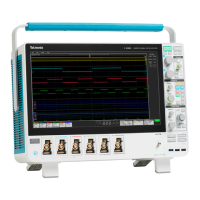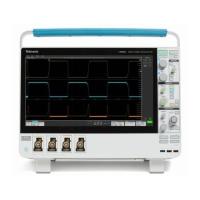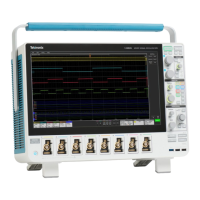The time stamps of all the frames can be output in tabular form for in-depth analysis using Excel or a wide variety of other
popular software tools that read comma-delimited files (.CSV).
NOTE. Enabling FastFrame mode disables FastAcq mode (if it was enabled). Likewise, enabling FastAcq mode disables
FastFrame mode (if it was enabled).
Waveform sample interpolation
When the sample density falls to less than one sample per display column, the instrument must calculate intermediate points to
display a waveform. This process is called interpolation.
There are three options for interpolation:
■
Sin(x)/x interpolation. Computes record points using a curve fit between the actual values acquired. It assumes that all the
interpolated points fall along that curve.
■
Linear interpolation. Computes record points between actual acquired samples by using a straight line fit. It assumes that all
the interpolated points fall in their appropriate point in time on that straight line.
■
Auto interpolation. Select the best interpolation method.
Coupling
All instruments and probes specify a maximum signal level. Do not exceed the limit, even momentarily, as the input channel or
probe may be damaged. Use external attenuators if necessary to prevent exceeding the limits.
Coupling determines whether an input signal is directly connected to the input channel (DC coupling), connected through a DC
blocking capacitor (AC coupling), or not connected at all (GND coupling).
The input resistance of each input channel can be 1 MΩ or 50 Ω. To properly terminate signals when using coaxial cables, or to
support active probes with different termination requirements, select the termination in the Channel menu Vertical Settings panel.
All probes expect a specific coupling and input termination. Both coupling and input termination are displayed on the screen. If
the instrument determines the coupling and termination required by the probe, either implicitly because of the TekProbe/TekVPI
interface or through performing a probe compensation, the instrument sets the required coupling and input termination.
Consider the following when you use 50 Ω termination with any channel:
■
The instrument does not accurately display frequencies under 200 kHz if AC coupling is selected.
■
The instrument reduces the maximum volts per division setting for the channel, since input amplitudes appropriate for the
higher settings would overload the 50 Ω input.
Waveform acquisition concepts
MSO54, MSO56, MSO58, MSO58LP, MSO64 Help 415

